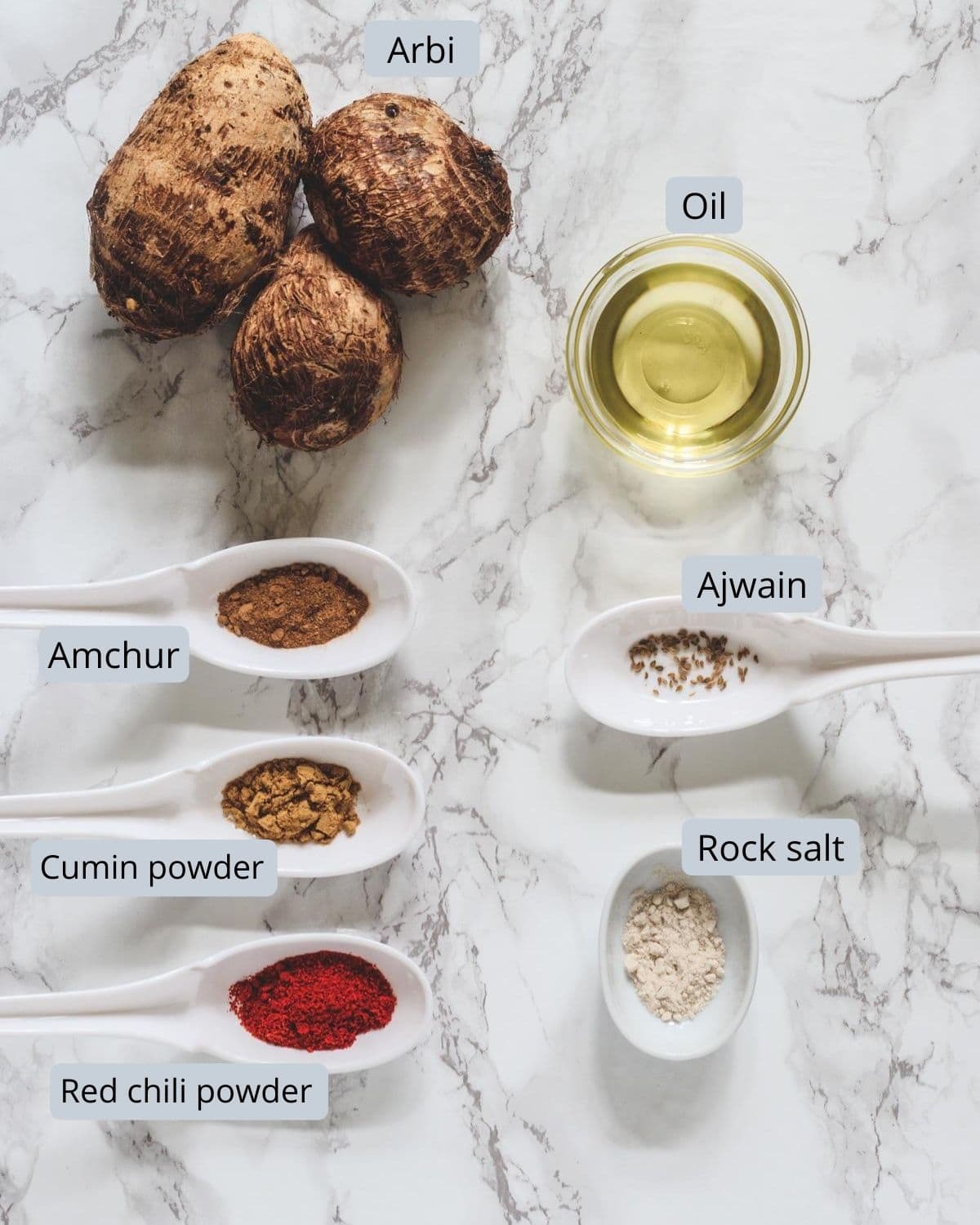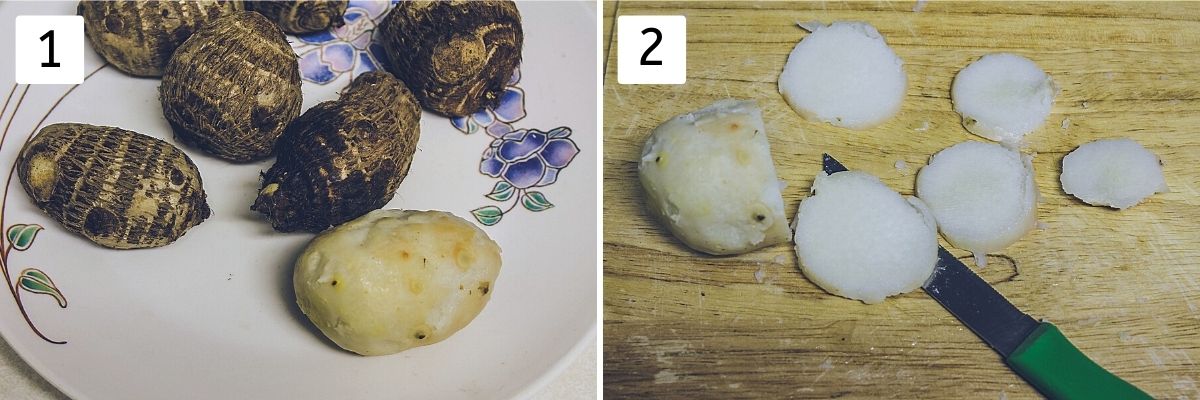This arbi fry makes a healthy side dish for your dal-chawal. It is super simple to make yet amazingly delicious.
All the ingredients used in this arbi fry recipe are suitable for Hindu fasting (vrat), so you can also enjoy this during your upvas.

Jump to:
❤️ You’ll Love This Arbi Fry Recipe
It requires only 6 ingredients (plus, salt). Yes, with this minimal stuff, you can make super delicious sukhi arbi fry.
You’ll need only 30 minutes to make. And half of the time is passive where you put the arbi in the pressure cooker for boiling.
Arbi (aka taro root) is full of nutrients with an excellent source of fiber.
This arbi fry is vegan and naturally gluten-free.
🧾 Ingredients For Sukhi Arbi Recipe
Here is the pic of the ingredients you’ll need to make this sukhi arbi fry.

- Arbi (Taro root): Many families consume it during the vrat days. Please follow your family tradition and if you’re not aware ask your elders.
- Rock salt: Because I made it for my fasting day, I have used rock salt. Regular table salt is not allowed in fasting. But when I make for regular days, I use table salt.
- Spice powders: If making for regular day meal, you are good. If making for fasting, add or skip the spices as per your family tradition. Some add red chili powder and some don’t. You can use green chilies instead.
👩🍳 How To Make Sukhi Arbi Fry? (Pics)
1) Boil the arbi first. Choose any one method. The time given is approx., it may vary depending on the size of the taro root.
- Pressure cooker: 1 whistle
- Microwave: 4-5 minutes on high power
- Boiling water in a saucepan: 10-15 minutes.
2) Once cool to touch, peel and discard the skin. Cut into round slices, or cut into cubes or lengthwise like wedges.

3) Heat the oil in a pan on medium heat. Once hot add ajwain and let them sizzle a bit.
4) Then add sliced arbi and fry in the oil for a few minutes or until it becomes slightly crisp. Because taro roots are slimy in nature, it is a good idea to cook until crisp to get rid of the slimy texture.
5) Now add salt and spices (red chili powder, cumin powder and amchur powder).
6) Mix well and cook for 1-2 minutes on low heat. Make sure to lower the heat so spices don’t get burnt.

🍽 Serving Ideas For Arbi Fry
On the regular days, sukhi arbi fry can be served as a side dish with your Indian meal (dal, rice or roti).
On the fasting days, it can be served with moraiyo and vrat ki kadhi.

Check Out Other Arbi Recipes
PS Tried this sukhi arbi fry recipe? Please leave a star rating in the recipe card below and/or a review in the comment section. I always appreciate your feedback!
Recipe Card
Sukhi Arbi Fry Recipe
Ingredients
- 6-7 or 1 ½ cup Arbi (taro root or colocasia) boiled, peeled and sliced
- 1 ½ tablespoons Oil
- ¼ teaspoon Ajwain (Carom seeds)
- Rock Salt (sendha namak) to taste
- 1 teaspoon Red chili powder
- ½ teaspoon Cumin powder
- ¼ teaspoon Amchur powder (Dried mango powder)
Instructions
- Boil the arbi first. Choose any one method. The time given is approx., it may vary depending on the size of the taro root. - Pressure cooker: 1 whistle - Microwave: 4-5 minutes on high power - Boiling water in a saucepan: 10-15 minutes.
- Once cool to touch, peel and discard the skin. Cut into round slices, or cut into cubes or lengthwise like wedges.
- Heat the oil in a pan on medium heat. Once hot add ajwain and let them sizzle a bit.
- Then add sliced arbi and fry in the oil for a few minutes or until it becomes slightly crisp. Because taro roots are slimy in nature, it is a good idea to cook until crisp to get rid of the slimy texture.
- Now add salt and spices (red chili powder, cumin powder and amchur powder). Mix well and cook for 1-2 minutes on low heat. Make sure to lower the heat so spices don’t get burnt.
Notes
- Please use peanut oil.
- Add or skip the spices as per your family tradition.
- If not eating red chili powder, then add green chilies after adding ajwain.
- If not eating amchur, then add lemon or lime juice at the end of the cooking process.



Raksha
Very nice pics and explanation
Kanan Patel
Thank you.